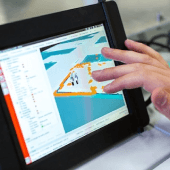Table of Content
Magnetic Particle Testing (MPT) is a crucial NDT method utilised across various industries to detect surface and near-surface flaws in ferromagnetic materials. Despite its widespread use, several misconceptions surround this testing technique, leading to misunderstandings about its capabilities and applications.
A fundamental technique for non-destructive testing is the magnetic testing method, which Alfred V. de Forest and Foster B. Doane developed in the 1930s. It requires understanding the composition of the parts being tested, as not all metals are ferromagnetic. Iron, nickel, and cobalt can be magnetised, while aluminum is used in 80% of aircraft materials. Daily bath concentration checks should be conducted to avoid contamination and detect differences in colour, layering, or banding. The amount of electricity used is crucial, as excessive use can mask defects. Working with an MT Level III is essential for creating effective testing methods.
Read More About Magnetic Particle Testing
How Magnetic Particle Testing Works?
MPT involves magnetising the test piece and applying ferromagnetic particles to the surface. If there are any discontinuities present, the magnetic field will cause the particles to gather in these areas, forming an indication that can be visually inspected.
The first step in MPT involves magnetising the test piece. Either a permanent magnet or an electromagnetic yoke can achieve this. By applying a magnetic field to the material, its magnetic domains align, creating poles on the surface. Any discontinuities within the material will interfere with this alignment, causing Magnetic Flux Leakage.
Once the test piece is magnetised, ferromagnetic particles are applied to the surface. These particles are typically suspended in a liquid carrier, allowing them to be evenly distributed over the area of interest. When applied, the particles are attracted to areas of magnetic flux leakage, such as cracks, voids, or other defects, forming visible indications on the surface.
Common Misconception About Magnetic Particle Testing
Contrary to popular belief, MPT can detect defects beyond the surface. By adjusting the testing parameters, such as magnetising current and particle concentration, MPT can identify subsurface defects, providing valuable insights into the material's integrity.
By adjusting factors like magnetising current and particle concentration, MPT can detect defects below the material's surface. This capability provides valuable insights into the overall integrity of the material being tested.
In essence, MPT is versatile and can be tailored to meet specific inspection requirements, including the detection of both surface and subsurface defects. Therefore, the notion that MPT can only detect surface defects is a misconception that fails to acknowledge its full potential in flaw detection and material evaluation. Here are a few points highlighting the most common misunderstandings about magnetic particle testing.
1. Limited Material Compatibility:
Many believe MPT is only suitable for ferromagnetic materials, overlooking its applicability to non-ferromagnetic alloys like austenitic stainless steels and nickel alloys. It is important to note that MPT can be used on a wide range of materials, not just ferromagnetic ones. Additionally, proper technique and equipment selection are crucial for accurate results in MPT inspections.
2. Complexity and Cost:
There's a misconception that MPT is complex and expensive, whereas it's relatively cost-effective compared to other NDT methods. In fact, MPT is known for its simplicity and ease of use, making it a popular choice for many industries. With proper training and equipment, MPT can be a cost-effective solution for detecting surface and near-surface defects in a variety of materials.
3. Perception of Obsolescence:
Despite being a time-tested technique, some view MPT as outdated, failing to recognise its continued relevance and integration with modern technology. In reality, advancements in technology have only enhanced the capabilities of MPT, allowing for more accurate and efficient inspections. By staying informed on the latest developments in MPT, industries can continue to benefit from this reliable testing method.
4. Myth of Limited Sensitivity:
Some assume MPT lacks sensitivity, whereas it can detect flaws as small as a few micrometres with proper calibration and technique. With the right expertise and equipment, MPT can provide highly detailed and precise results, making it a valuable tool in various industries. It is important to understand the capabilities of MPT and invest in proper training to maximise its effectiveness.
5. Importance of Proper Procedure:
Failure to follow standardised testing procedures can lead to missed defects or false indications, emphasising the need for adherence to proper techniques. Proper procedure also ensures consistency and reliability in results, ultimately improving the overall quality of inspections. It is crucial for technicians to stay updated on best practices and guidelines to ensure accurate and reliable testing outcomes.
6. Misconception of Incompatibility:
MPT can complement other NDT methods, such as ultrasonic testing and radiography, providing a comprehensive assessment of material integrity. By understanding the strengths and limitations of each method, technicians can choose the most appropriate technique or combination of techniques for thorough inspections. This holistic approach can enhance the accuracy and effectiveness of defect detection in various materials and components.
7. Requirement of Specialised Training:
While proficiency in MPT requires training and certification, specialised knowledge is not always necessary, as many programmes offer comprehensive courses suitable for various skill levels. It is important for technicians to stay updated on the latest advancements in MPT technology and techniques to ensure accurate results. Continuous education and training can help technicians improve their skills and stay competitive in the field.
These points address key misconceptions and highlight the importance and versatility of magnetic particle testing in various industries.













